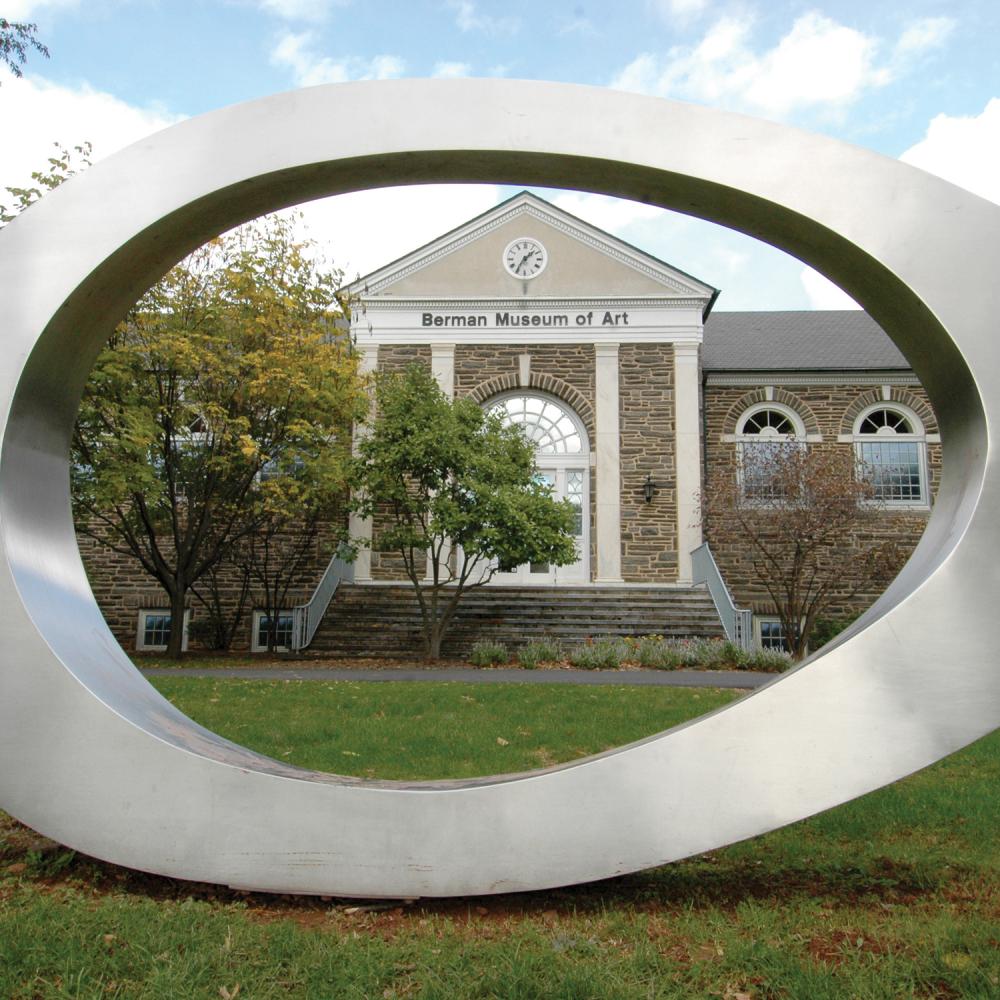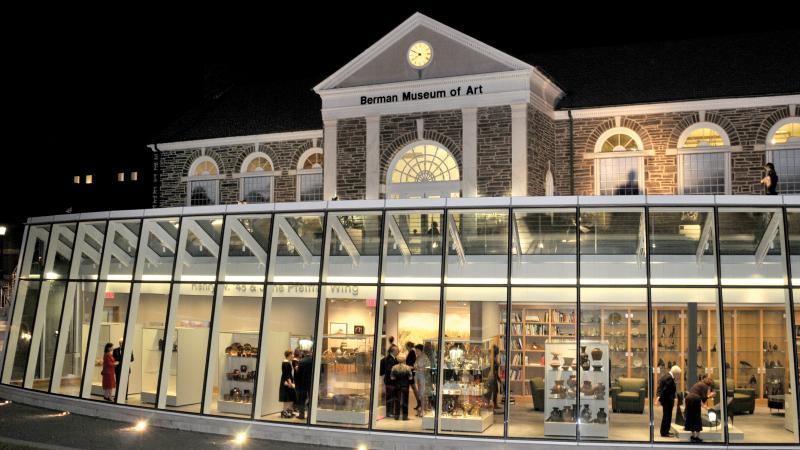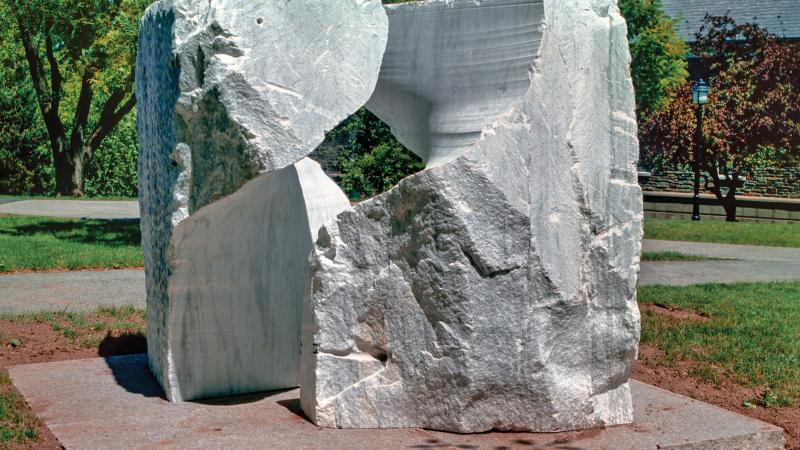The sunlight in Collegeville, Pennsylvania, can suddenly glance off a fan-tailed ebony figure the size of a pterodactyl, dance along the shimmering edge of a stainless steel oval, and then settle down with warmth and comfort upon a fortress-like enfilade of walls that shake with grief. I have no idea what it’s like at night among the fifty or so pieces of sculpture standing, lying, and sometimes soaring throughout the hundred-and-seventy acre campus of Ursinus College. But I childishly picture the stolid statue of German Reformation theologian Zacharias Ursinus, which rises column-like near Romanesque Bomberger Hall, coming to life, stepping down from its plinth, and wandering among the modern pieces a little moonstruck. I imagine Reverend Ursinus finding his surroundings quite remarkable.
That stainless steel oval beckoning to hurdlers anchors the entire collection at Ursinus. Created by G. Noble Wagner (the “G” is for Gladys), The Oval makes an elegant and eloquent opening statement about the collection. Peer through it at just the right angle and what you have is a landscape—the tree-dotted expanse of the campus that stretches along Main Street. Take a gander through its shiny frame almost edge on and what you get is a two-story red-brick home adjacent to campus and now belonging to the college, some modest row houses across the street, and farther on a pizzeria. An art teacher and philosopher who had lived and worked in nearby Cheltenham, Wagner seems to be asking visitors to look at her art and all the art on campus from every angle.
Lynn Chadwick’s many pieces around the academic lawns are welded bronze figures that make the sculptor’s bond with his material plain. Chadwick, trained as a designer, worked for years for architectural firms before turning to the creation of mobiles, stabiles, and finally, after having taken some classes in welding, the characteristic bronze pieces that have made up the bulk of his work since the late 1950s.
Couple on Seat, The Watchers, and Walking Woman are three of Chadwick’s strongest pieces at Ursinus. All have the characteristic Chadwick trademark of featureless geometric shapes as notations for heads. The first piece looks down a sloping expanse of campus toward Main Street. The cloaked couple—man with cube for head and woman with triangle—with tapered legs, await our wonderment. The larger-than-life figures seem unfazed themselves as sunlight touches their angled forms and draws the eye to Chadwick’s welded joints, sometimes left rough and unfinished. The couple have a solidity to them. Tap on their squared-off shoulders and you both feel and hear it. Chadwick used to say that he just worked on his pieces until they became “something in their own right.” Couple on Seat is indeed that, you realize, as you make the full 360-degree circumference of their presence.
The Watchers, tucked off to one side of the Berman Museum of Art, is something in its own right, too, something unsettling. The three figures stand aside like uninvited guests, perhaps recording their Spock-like observations with their rectangular-shaped noggins. Walking Woman, with just a few minor alterations becomes elegant, even fashionable, in her promenade alongside a walkway near the center of campus. Trailing behind her is a lovely set of tail plumes that enhance and add balance, even ballast, to the figure. Simplicity of form, it seems, was a way for Chadwick to explore diversity. He designed hundreds of maquettes and fully realized pieces, all along the same lines—literally—yet each has its own unique captivating embodiment.
Across campus stands a piece that moves nearly everyone who happens by, even those generally mistrustful of modern sculpture. Richard Gottlieb’s Weeping Walls is massive, rising to about twelve or fifteen feet and comprising four steel slabs spaced out and balanced along a cradle-like plinth some twenty feet in length. The rusted steel gives the piece a battered look certainly, but like the hull of an aged ship it conveys something of the rough weather or times it’s gone through. So, plenty of hardship here to grab the attention of the odd English major on her way to the Milton seminar. And even though walls usually rise above it all, so to speak, that’s not the case here. Set apart, one from the other, these are divided and seem stricken with some calamity. The artful unity of Weeping Walls, however, recommends contemplation. Nearby is a labyrinth walk, where the perplexed can follow stony paths, deep in thought.
This plein-air gallery is one of those riches of advanced society we are privileged to enjoy. But who is responsible for bringing all this sculpture to a tiny liberal arts school twenty-five miles northwest of Philadelphia? Philip Berman and his wife, Muriel, long-time residents of Allentown, can take most of the credit, having collected many of the pieces for their home and later donating them to Ursinus as part of what has become a renowned outdoor sculpture collection.
The Bermans began collecting and learning about art early in their marriage, and they eventually became friends with many of the artists they collected, especially the sculptors. The art books they collected over a lifetime now take up many shelves of the Berman Special Collection in the Myrin Library and reflect their varied interests and informed sensibilities. A smattering of the titles I saw: Point and Line to Plane by Wassily Kandinsky; What Is Art for? by Ellen Dissanayake; Parkland: A Visit in Each Season, Three Months’ Work, Yorkshire Sculpture by noted contemporary sculptor Andy Goldsworthy; Merchants and Masterpieces by Calvin Tomkins (two copies); many books on Michelangelo, Auguste Rodin, Aristide Maillol, Alexander Calder, Isamu Noguchi, Henry Moore, Claes Oldenburg, and Robert Indiana; as well as books about art on college campuses, on artists and collectors and the law, and a hefty biography of Zacharias Ursinus. The Bermans were collectors who learned both by doing and by reading up.
One thing lacking in the collection is whimsy. The general air of sobriety is appropriate, however, in keeping with the history of Ursinus itself. Founded in 1869 by the theologian John Henry Augustus Bomberger as a reaction against high-church tendencies in the German Reformed Church, Ursinus College educated young men in moral philosophy. Instruction was egalitarian, unpretentious, humble, and frugal.
The Ursinus campus of today seems like any other American campus: One can imagine students getting rowdy after a football victory over, say, Juniata or Muhlenberg. But when I asked passing students about vandalism or mistreatment of the pieces, none could recall even a single roll of toilet paper draping these works of art. For a photo op someone might slip a brightly colored knit cap over the head of the granny who sits on a bench knitting in J. Seward Johnson Jr.’s Getting Involved VIII, and then there are the young wags who might occasionally climb up on opposite sides of the plinth of Weeping Walls to get it rocking slightly, but no harm done. The place is called Collegeville, after all.
Not every piece in Ursinus’s collection came from the Bermans. Wagner’s The Oval was a gift from her children. Synagogue by Christopher Cairns came from Ursinus alum and philanthropist Betty U. Musser. In Cairns’s piece, a woman stands stock straight on top of a column of rock and seems inseparable from it, the two forming a somber bronze pillar. The figure’s face is downcast and grim, seeming to consider the consequences of her bodily assembly with the stone she towers over. Whether she’s held up and liberated or drawn down and imprisoned by this “bringing together” (as the literal sense of “synagogue” denotes) is left for the viewer to decide.
Echoes of the Holocaust(Synagogue seems in fact to be one of them) are heard in this quiet collection, especially in Aggressive Couple by Israeli artist Igael Tumarkin. Born in Germany in 1933, Tumarkin’s family emigrated to Palestine when he was two. He has a piece in Rabin Square in Tel Aviv that serves as a memorial to Holocaust victims. His piece in the Ursinus collection evokes the systematic roundup and transport of Jews and others to death camps. The entire steel piece is painted bright red, suggesting the incineration of the bodies of those gassed and disposed of by the Nazis. A railcar wheel-and-axle assembly is set on a twenty-one-foot-long segment of rails, secured by chain, with a two-dimensional and ominous silhouette overseeing the whole.
While Tumarkin’s piece seems to be leading to a hopeless outcome, another work, called Rebirth, by Steve Tobin—offers a glimmer of hope. Sheets of steel in many different attitudes rise from a recessed base at various angles, suggesting the freedom for some lucky few prisoners released at the end of World War II. One young woman I happened across said she found Tobin’s to be the most moving work in the collection.
The changing light at Ursinus falls upon at least one other piece that speaks to the experience of the Holocaust: George Anthonisen’s I Set Before You This Day, a gift to the collection from the sculptor and his wife. The relatively small work in bronze is the centerpiece of a new sculpture terrace at the Berman Museum, which is on campus. Nine figures—some with the Star of David visible on an outer garment—appear to be groping for answers. Each instant, the piece suggests, requires a decision or an action, a coming down—as the piece’s title from Deuteronomy suggests—on the side of either life or death. The figures in their many attitudes are reminiscent of Rodin’s The Burghers of Calais and the work is a fitting tribute to the master.
Many pieces in the collection, however, resist direct interpretation. If they’re “about” anything, it is the effect of mass in space and how pure form creates visual experience. Three pieces in particular fall into this category: the sky-piercing Rising Path by Zigi Ben-Haim, Harmony by Daniel Kaintz, and Temple by Mary Ann Unger. The green acrylic and polished steel of the two jagged pieces of Rising Path that literally mirror each other may startle the viewer at first, set as they are in a wooded residential village on campus. You walk between the pieces, notice the ghost-like lines wiggling across the piece’s interior and look up, almost rising upward yourself by the sensation. Temple, beneath the canopy of an oak near the library, has the same effect as you squeeze your way inside the domed structure, which resembles a dream-like house of cards. Here again what you notice is sky, tree tops, space, compartmentalized by the hundreds of slats that surround. This glimpsing art from the inside out is at play, too, in Harmony, a block of marble with several bore holes that has been rent asunder. The two chunks of marble could in fact fit back together snugly, if, say, the offensive linemen of the Ursinus Bears put a shoulder to them, but for the viewer the delight is in following the rough contours of the exteriors as they contrast with the smoother interiors.
The six hours or so it takes to see every piece in the sculpture collection at Ursinus is time well spent for anyone hoping to understand the direction of modern sculpture. From the hyperrealism of some of the figures sitting on benches, and the figurative art of Anthonisen, which celebrates the classical tradition, to the cubist and expressionistic quality of many of Chadwick’s pieces and, finally, to the many sculptures that are minimalist and abstract, the collection is a cross section of sculptors’ efforts to come to grips with creating visual experiences in the modern era. The way these pieces become part of the landscape or built environment throughout the campus, inviting and redirecting our attention—often skyward—is what makes this collection, to borrow Lynn Chadwick’s term, something in its own right, or even, considering how the pieces transform our ways of seeing and looking, something in its own light.




